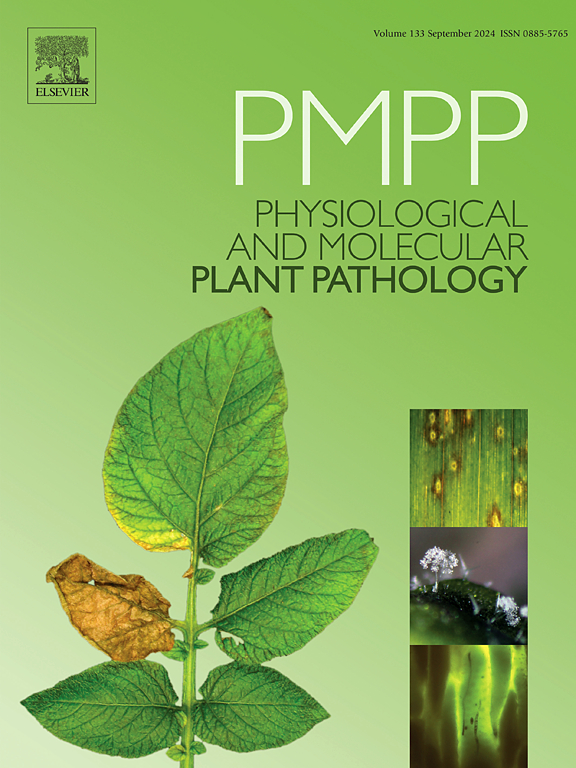转录组分析为解淀粉芽孢杆菌HN11诱导烟草根腐病抗性的机制提供了新的思路
IF 2.8
3区 农林科学
Q2 PLANT SCIENCES
引用次数: 0
摘要
烟草镰刀菌根腐病是近年来中国南方烟草种植区最主要的土传真菌病害,危害范围广。解淀粉芽孢杆菌HN11是一株从楝树根际分离的生物防治菌株,在稻-烟轮作中表现出显著的防治效果。已观察到HN11能诱导烟草对该病害产生抗性。本试验研究了解淀粉芽孢杆菌HN11在烟草中防治枯萎病根腐病的诱导抗性机制。结果表明,HN11主要通过乙烯和茉莉酸途径诱导烟草产生抗性。在没有接种尖孢镰刀菌JSJ的情况下,HN11通过α -亚麻酸代谢途径中的激活基因间接积累茉莉酸盐。烟草植株接种F. oxysporum JSJ后,HN11通过上调植物激素信号转导通路和MAPK信号级联相关基因,促进了乙烯的积累和信号转导。此外,HN11还诱导烟草抗性相关物质的合成。此外,还观察到与活性氧信号转导和局部快速抗性反应相关的基因上调,从而增强烟草对镰刀菌根腐病的抗性。本文章由计算机程序翻译,如有差异,请以英文原文为准。
Transcriptome analysis offers insights into the mechanisms underlying the induction of resistance against Fusarium root rot in tobacco by Bacillus amyloliquefaciens HN11
Tobacco Fusarium root rot has been recognized as the most predominant soil-borne fungal disease in tobacco-growing regions of southern China in recent years, causing extensive damage across a wide area. Bacillus amyloliquefaciens HN11, a biocontrol strain isolated from the rhizosphere of neem, has demonstrated notable efficacy in the rice-tobacco rotation system. It has been observed that HN11 can induce resistance in tobacco against the disease. This study was conducted to investigate the resistance-inducing mechanisms of B. amyloliquefaciens HN11 in tobacco to control Fusarium root rot. These results indicate that the induction of resistance in tobacco by HN11 was predominantly dependent on ethylene and jasmonic acid pathways. In the absence of Fusarium oxysporum JSJ inoculation, jasmonates were indirectly accumulated by HN11 through the activating genes within the alpha-linolenic acid metabolic pathway. When tobacco plants were inoculated with F. oxysporum JSJ, the accumulation and signaling of ethylene were facilitated by HN11 through the upregulation of genes involved in the phytohormone signaling transduction pathway and the MAPK signaling cascade. Additionally, the synthesis of resistance-related substances in tobacco was induced by HN11. Furthermore, upregulation of genes linked to reactive oxygen species signal transduction and local rapid resistance responses were also observed, thereby enhancing the resistance of tobacco to Fusarium root rot disease.
求助全文
通过发布文献求助,成功后即可免费获取论文全文。
去求助
来源期刊
CiteScore
4.30
自引率
7.40%
发文量
130
审稿时长
38 days
期刊介绍:
Physiological and Molecular Plant Pathology provides an International forum for original research papers, reviews, and commentaries on all aspects of the molecular biology, biochemistry, physiology, histology and cytology, genetics and evolution of plant-microbe interactions.
Papers on all kinds of infective pathogen, including viruses, prokaryotes, fungi, and nematodes, as well as mutualistic organisms such as Rhizobium and mycorrhyzal fungi, are acceptable as long as they have a bearing on the interaction between pathogen and plant.

 求助内容:
求助内容: 应助结果提醒方式:
应助结果提醒方式:


